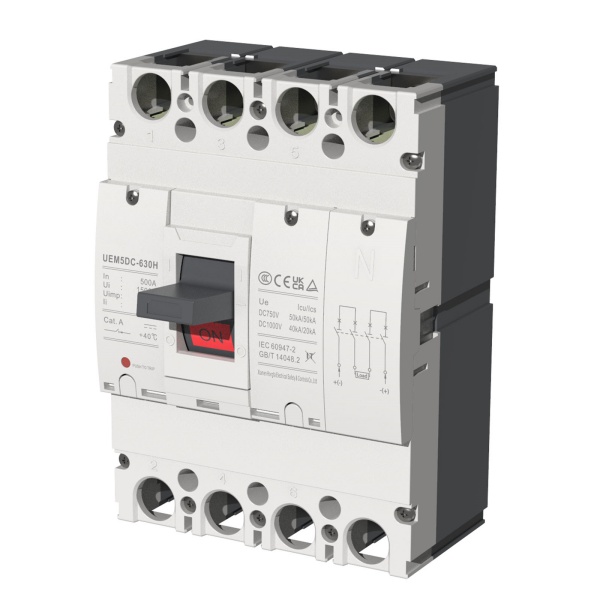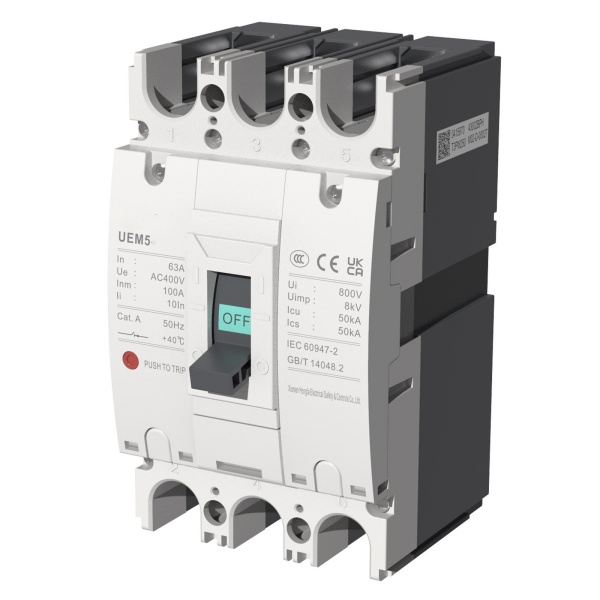In the field of electrical engineering, molded case circuit breakers are widely used in circuit overload and short circuit protection as a key protection device. This device is favored for its enclosed design, ease of operation and modular auxiliary components. Today, we will explore the working principle of molded case circuit breakers, its role in circuit protection, and its unique characteristics in order to better understand the function and importance of this device.

UEM5DC MCCB Circuit Breaker
1. What is a molded case circuit breaker?
Molded case circuit breakers are also called device-type circuit breakers. All parts are sealed in a plastic shell. Auxiliary contacts, undervoltage releases, and shunt releases are mostly modular. Due to the very compact structure, molded case circuit breakers are basically impossible to repair. They are mostly manually operated, and large capacity can be selected for electric separation and closing. Due to the application of electronic overcurrent releases, molded case circuit breakers can also be divided into Class A and Class B. Class B has good three-stage protection characteristics, but due to price factors, Class A products using thermal magnetic releases have a higher market share. Molded case circuit breakers are circuit breakers that have contacts, arc extinguishing chambers, trippers and operating mechanisms all installed in a plastic casing. They are generally not considered for maintenance and are suitable for branch circuit protection switches. Overcurrent trippers are of two types: thermal magnetic and electronic. Generally, thermal magnetic molded case circuit breakers are non-selective circuit breakers with only two protection modes: long delay for overload and instantaneous short circuit. Electronic molded case circuit breakers have four protection functions: long delay for overload, short delay for short circuit, instantaneous short circuit and ground fault. Some newly launched electronic molded case circuit breakers also have a regional selective interlocking function.
2. Working principle
Most molded case circuit breakers are manually operated, and some are equipped with motor operating mechanisms.
(1) Mechanical interlocking devices generally use wire ropes or lever mechanisms to change the mechanical position (multi-function program locks can also be used) to ensure that the operating handle of the disconnector cannot be moved before the circuit breaker cuts off the power supply.
(2) Electrical interlocking device There are generally two interlocking modes for electrical interlocking. One is to control the handle of the isolating switch through the linkage auxiliary contact (normally open or normally closed) on the operating mechanism. When the circuit breaker is not disconnected, the isolating switch operating handle cannot be moved.
The other electrical interlocking is to use the linkage auxiliary contact (normally open or normally closed) on the distance switch operating mechanism to control the circuit breaker. When the handle of the isolating switch is pulled, the linkage auxiliary contact (normally open or normally closed) causes the circuit breaker to operate to cut off the circuit, thereby preventing accidents caused by pulling the distance switch with load.
3. Functions
(1) Connect and disconnect the no-load and load current in the high-voltage circuit under normal conditions;
(2) When a system fault occurs, it can cooperate with the protection device and the automatic device to quickly cut off the fault current to prevent the accident from expanding and ensure the safe operation of the system.
Generally, there is no problem with lubrication of the molded case circuit breaker itself, and it is often its operating mechanism that needs lubrication. The function of the thermal relay is to automatically cut off the power supply when the motor is overloaded. The structure of the thermal relay is composed of two metal sheets with different expansion coefficients. When the current is too large, the one with a larger expansion coefficient expands first, which plays the role of cutting off the power supply. After the thermal relay is activated, there are manual reset and automatic reset. Function of the fuse: When a circuit fails or is abnormal, the current continues to rise, and the rising current may damage some important or valuable components in the circuit, and may also burn the circuit or even cause a fire.
4. Characteristics
(1) Rated ultimate short-circuit breaking capacity Icu: There are two types of breaking capacity indicators for circuit breakers: rated ultimate short-circuit breaking capacity Icu and rated operating short-circuit breaking capacity Ics. As a characteristic parameter, Ics does not simply consider the breaking capacity of the circuit breaker, but as a breaking indicator, that is, after breaking several short-circuit faults, it can still ensure its normal operation.
(2) Current limiting breaking capacity: When a circuit breaker short-circuits, the contacts open quickly to generate an arc, which is equivalent to inserting a rapidly increasing arc resistor in series in the line, thereby limiting the increase of fault current. The shorter the circuit breaker disconnection time, the closer Ics is to Icu, the better the current limiting effect is, and the adverse effects of electromagnetic effect, electrodynamic effect and thermal effect caused by short-circuit current on circuit breakers and electrical equipment can be greatly reduced, thus extending the service life of circuit breakers.
(3) Short-circuit protection: Short-circuit protection is short-circuit instantaneous tripping. It is important to adjust the setting value of the protection in time after the load changes to prevent frequent tripping due to too small setting value affecting the power supply quality, or too large setting value causing the line and equipment to be ineffectively protected.
(4) Overload delay protection: Overload delay protection means that when the load current exceeds the specified range of the equipment and there is a risk of burning the equipment, the protection device can cut off the power supply within a certain period of time. Overload has a process of heat accumulation, and the protection action does not need to be too rapid. For short-term overcurrent, the protection should not be activated.
(5) Isolation function: The isolation function requires that the leakage current after the circuit breaker is disconnected will not cause harm to people and equipment. After multiple short-circuit trips, the switch performance will decrease and the leakage current will increase. For the human body, a safe leakage current of less than 30mA is considered safe. However, in a harsh environment, a leakage current of more than 300mA for more than 2 hours may damage the insulation and cause a phase-to-ground short circuit, which may lead to a fire.

UEM5 AC MCCB Circuit Breaker
Molded case circuit breakers play an important role in electrical systems with their compact structure, easy operation and high safety. They ensure the safe operation of circuits through different protection functions, such as short circuit and overload protection. However, molded case circuit breakers also have some limitations, such as difficulty in maintenance and possible frequent tripping problems. In order to improve the safety and efficiency of electricity use, it is recommended to check regularly and set the protection parameters reasonably.
Post time: 7 月-17-2024


